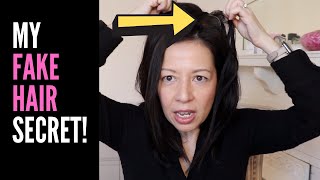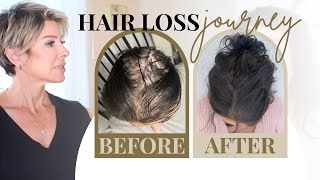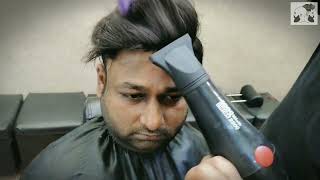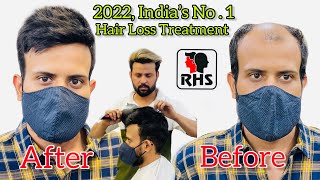What is the Best Treatment for Female Pattern Baldness?
- Posted on 13 October, 2021
- Hot Topic
- By SNY Admin
Hair loss in women often has a greater impact than hair loss does in men, because it’s less socially acceptable for them. In this article, we will concentrate on the current treatment concepts of female pattern baldness.
Before thinking of embarking on SMP for women, let us first take a look at its treatment. Your problem might just as well be simple like hair loss in summer.
What’s Hair Loss in Women?
Hair loss in women is just that — when a woman experiences unexpected, heavy loss of hair. Generally, humans shed between 50 and 100 single hairs per day. Hair shedding is part of a natural balance — some hairs fall out while others grow in.
Female pattern hair loss also called androgenetic alopecia, is hair loss that affects women. It’s similar to male pattern baldness, except that women can lose their hair in a different pattern than men.
Currently, it is not clear if androgens (male sex hormones) play a role in FPHL, although androgens have a clear role in male pattern baldness. Due to this uncertain relationship, the term FPHL is preferred to ‘female androgenetic alopecia.
Psychological effects of androgenetic alopecia on women: comparisons with balding men and with female control subjects are studied, not mentioning the placebo-controlled trial and the study on drug-induced hair loss.
Cycles of Hair Growth
1. Anagen: Growing phase
The stages of hair growth begin with the anagen phase. It’s the longest phase, lasting about 3 to 5 years for the hairs on your head, though for some people a single hair could continue growing for 7 or more years. Some say that the scalp hair can last up to six years or even longer.
With successive anagen cycles, the follicles become smaller (leading to shorter, finer hair)
2. Catagen: The transition phase
The catagen phase starts when the anagen phase ends, and tends to last about 10 days or so. During this chapter, hair follicles shrink and the growth of hair slows. The hair also separates from the bottom of the hair follicle, yet remains in place during its final days of growing.
3. Telogen: Resting phase
The telogen phase typically lasts around 3 months. An estimated 10 to 15 percent of your scalp hairs are in this phase.
Hairs don’t grow during the telogen phase, but they don’t usually fall out either. The telogen phase is also when new hairs start to form in follicles that have just released hairs during the catagen phase.
4. Exogen: Shedding phase
The exogen phase is essentially an extension or a part of the telogen stage of the growth of hair. During the exogen phase, hair is shed from the scalp, often helped along by washing and brushing. Losing 50 to 100 hairs per day during the exogen phase is normal.
During the exogen phase, which can last about 2 to 5 months, new hairs are growing in the follicles as old hairs fall away.
Patterns of Female Hair Loss
Doctors divide female pattern baldness into three types:
Type I – is minimal thinning that can be camouflaged with hair styling techniques.
Type II – involves widening of the part, and increased thinning around it.
Type III – Is thinning throughout, with a see-through area at the top of your scalp.
Types of Hair Loss
Visible hair loss occurs in approximately one-half of all persons by the age of 50 years. Here are some types of hair loss.
Androgenetic Alopecia
Androgenetic alopecia is the most common type of hair loss. Commonly known as male pattern hair loss or female pattern hair loss, androgenetic alopecia is hereditary but can be managed with medication or surgery.
Female pattern hair loss (FPHL) is a distinctive form of diffuse hair loss that occurs in women with androgenetic alopecia because the hair loss in androgenetic alopecia is an aberration of the normal hair cycle.
Telogen Effluvium
Telogen effluvium, a type of hair loss, occurs when large numbers of follicles on the scalp enter the resting phase of the growth cycle of hair, called telogen, but the next growth phase doesn’t begin. This causes hair to fall out all over the scalp without novel hair. Chronic telogen effluvium (CTE) can be secondary to thyroid disease, systemic lupus, drug ingestion, and iron deficiency anemia.
Anagen Effluvium
Anagen effluvium is rapid hair loss resulting from medical treatment, such as chemotherapy. These potent and fast-acting medications kill cancer cells, but they may also shut down hair follicle production in the scalp and other parts of the body.
Alopecia Areata
Alopecia areata is an autoimmune condition, which means the body’s immune system attacks healthy tissues, including the hair follicles. This causes hair to fall out and prevents fresh hair from growing. Alopecia areata is an autoimmune skin disease that causes patchy hair loss on your head and possibly other places on your body. It’s usually not permanent.
Tinea Capitis
Tinea capitis, also called scalp ringworm, is a fungal infection of the scalp that’s a common cause of hair loss in children. This condition causes hair to fall out in patches, sometimes circular, leading to bald spots that may get bigger over time.
Cicatricial Alopecia
Cicatricial alopecia, also known as scarring alopecia, is a rare type of hair loss in which inflammation destroys hair follicles and causes scar tissue to form in their place. After scar tissue forms, hair doesn’t regrow.
Hair Shaft Abnormalities
Several types of hair shaft abnormalities can lead to hair loss. These conditions cause strands of hair to thin and weaken, making them vulnerable to breaking. The hair loss doesn’t occur in the follicle but as a result of a break somewhere along the hair shaft, which is the visible part of a hair strand. This can result in overall thinning, as well as in many small, brittle hairs.
Hypotrichosis
Hypotrichosis is a rare genetic condition in which very little hair grows on the scalp and body and excessive hair growth in the wrong places, such as the cheeks or forehead.
Babies born with this condition may have typical growth of hair at first; however, their hair falls out a few months later and is replaced with sparse hair.
Signs of Hair Loss in Women
Signs and symptoms of hair loss may include:
- Gradual thinning on top of the head. This is the most common type of hair loss, affecting people as they age.
- Circular or patchy bald spots.
- Sudden missing hair.
- Full-body hair loss.
- Patches of scalinôg that spread over the scalp.
- Seeing scalp skin through hair.
How to Stop Thinning Hair
Among postmenopausal women, as many as two-thirds suffer hair thinning or bald spots.
In FPHL, there is diffuse thinning of hair on the scalp due to increased hair shedding or a reduction in hair volume, or both. Hair thins mainly on the top and crown of the scalp.
Some women do experience hair regrowth with treatment. Your treatment plan will likely consist of one or more medications approved to treat hair loss. In most women, it may slow or stop hair loss.
How to stop thinning of hair and hair loss in women treated? Here are some medical treatments for female pattern hair loss that may help.
1. Scalp massage
Perhaps the cheapest method of getting thicker hair is a scalp massage. It doesn’t cost anything, and there are no side effects.
2. Essential oils
Essential oils are liquids derived from certain plants, and they’re primarily used in aromatherapy and other types of alternative medicine.
3. Anti-thinning shampoo
Anti-thinning shampoo works in two ways. First, such products provide volume for your hair, so it looks thicker. This can be helpful for people who have thin or naturally fine hair.
4. Multivitamins
Healthy hair is dependent on your overall good health. In cases of malnourishment, or with certain eating disorders, fresh hair may fail to generate from follicles.
For that reason, there is a surge of studies performed on the effect of a nutritional supplement on hair loss in women.
5. Folic acid supplements
Folic acid is a type of B vitamin that’s important for new cell generation. In terms of thinning hair, folic acid is thought to help follicles generate new hair in balding areas.
6. Biotin
Biotin, or vitamin B-7, is a water-soluble nutrient that’s naturally found in foods such as nuts, lentils, and the liver. If you eat a balanced diet, it’s unlikely that you’re low in biotin. It also promoted to thicken hair.
7. Omega-3 and omega-6 fatty acids
Omega-3 and omega-6 fatty acids are called essential fatty acids. This is because they can’t be made by the human body. Omega-3 helps your body fight inflammation, an underlying cause of numerous conditions.
Hair building fibers are keratin fibers available in a range of natural hair colors.
8. Minoxidil
Minoxidil (Rogaine) is the only drug approved by the U. S. Food and Drug Administration (FDA) to treat female pattern baldness. It has the potential role of minoxidil in the hair transplanting setting. You apply it to your dry scalp.
Research studies confirmed that minoxidil applied directly to the scalp could stimulate the growth of hair. This hair loss treatment is available over the counter. If minoxidil does not work, your provider may recommend other medicines, such as spironolactone, cimetidine, birth control pills, ketoconazole, among others.
Recently found, that scalp irritation after use of topical minoxidil solutions result from contact dermatitis to propylene glycol, one of the vehicles of the solution, rather than the minoxidil itself.
9. Spironolactone
Spironolactone (Aldactone) is prescribed for people who have thinning hair related to androgen production. While technically a “water pill,” Aldactone is an anti-androgen, too. Oral spironolactone therapy for female patients with acne, hirsutism, or androgenic alopecia is also available.
Spironolactone (25 mg daily) has been shown to significantly improve the growth of hair, reduce shedding and improve hair density.
Some women who don’t respond to minoxidil may benefit from the addition of the anti-androgen drug spironolactone (Aldactone) for the treatment of androgenic alopecia. This is especially true for women with polycystic ovary syndrome (PCOS) because they tend to make excess androgens.
10. Finasteride
Finasteride (Propecia) is a prescription hair loss medication. It’s for men only. Unlike topical treatments like minoxidil, Propecia comes as a daily pill that men take for hair loss.
However, finasteride should not be used in women of childbearing age, because 5α-reductase inhibitors may cause abnormalities of the external genitalia in the male fetus.
11. Corticosteroids
Corticosteroids are prescription treatments used for conditions linked to underlying inflammation. Sometimes, inflammatory conditions can cause a variety of symptoms, including hair loss.
The most common treatment for alopecia areata is the intralesional injection of a corticosteroid, preferably triamcinolone acetonide (Kenalog).
12. At-home laser therapy
Researchers continue to look for new ways to stimulate hair growth and stop hair breakage. Other treatments that you may find for FPHL include the following. Laser therapy is typically used by dermatologists and other skin specialists. Now, the FDA has cleared the way for some products to be used at home. At-home laser therapy for hair is intended to help regrow your hair while also making it thicker.
We still do not know whether these devices are safe for long-term use or if they can continue to produce new hair growth. Not all patients need screening blood tests.
SMP for Excessive Hair Loss
If you notice that you’re losing hair, see your doctor or a dermatologist. Dermatologists are the experts in diagnosing and treating hair loss. A dermatologist can tell you whether it’s FPHR or something else that is causing your hair loss. If necessary they would perform a scalp biopsy to confirm this diagnosis. Other causes of hair loss can look like FPHL, so it’s important to rule out these causes.
Scalp Micropigmentation (SMP) is one of the most effective treatment options for those experiencing hair shedding. It can restore receded hairlines, thicken remaining hair, and camouflage female pattern hair loss.
Bottom Line
If you have a medical condition like alopecia areata, the dermatologist may prescribe medications or recommend an over-the-counter treatment. In-office procedures can also be effective for some patients. These treatments can include corticosteroid injections, laser therapy, and platelet-rich plasma therapy.
Hair transplantation for FPHL is becoming more popular although not everyone is suitable for this procedure. Today, most hair transplants look completely natural. However, as mentioned, not everyone is a good candidate for a hair transplant.
If you have other symptoms, such as an irregular period, severe acne, or increase unwanted hair, consult your doctor. You may be experiencing a different type of hair loss.




